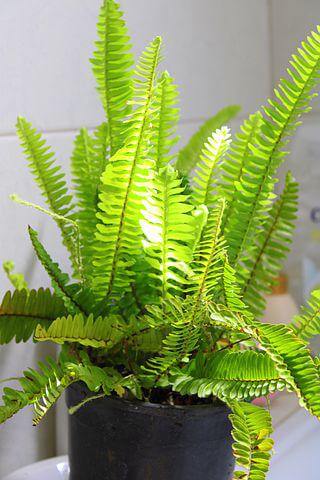Last Updated on January 10, 2023 by a Friendly Gardener
Botanically known as the Nephrolepsisex alta bostoniensis, the exuberant Boston Fern is a member of the Dryopteridaceae family. This lush and happy-looking houseplant is very popular as a bit of indoor greenery globally. There are over 200 varieties of the Boston Fern.
The Boston fern was born when a fern mutation was discovered in 1895 by a florist in Massachusetts near Boston. It was found in a group of more than two hundred Sword ferns that are native to the American tropics and the state of Florida.
Boston Fern Plant Care

Boston ferns prefer a humid and warm environment. Extreme temperatures and outdoor cultivation will cause them to suffer and decline. When cultivated indoors, they need protection from drafts and should never be located in the vicinity of air conditioning or heating vents, or drafty windows. They will flourish if placed in an environment offering stable temperatures and humidity levels.
The soil bed of a Boston fern needs to retain moisture so frequent watering is necessary. They also will benefit from regular feeding during ì the entire growing season beginning in spring through fall.
Soil
A rich peat-based loamy potting mix is recommended for good drainage. Without proper drainage, your fern will be subject to root rot which will end up killing your plant. If you’d like to mix your potting soil blend, use 50% peat moss, 38% perlite, and 12% horticultural bark to create the best soil bed.
Light
Boston ferns thrive in very bright indirect light. When placed in the shade, their fronds will not boast the best appearance, and the plant may drop its leaves. Excessive sunlight will burn them. These plants require bright indirect sunlight whether cultivated indoors or outdoors. All direct sunlight exposure is to be avoided.
Water and Humidity
It is imperative that a fern’s soil bed be always kept moist. This should not be confused with soggy or water-logged. If you allow the soil bed to dry out, the fern’s fronds will do likewise, then drop from the plant. Watering should be reduced in fall and winter as the plant is not growing. The best possible advice is to keep an eye on the plant’s fronds. If they appear to be dry, water them more often or increase the amount.
The principal reason that Boston ferns fail is a dry soil bed. Try soaking your Boston fern monthly. Soak in a sink and then leave the plant to drain completely before returning it to its habitual location. Chlorinated water should be avoided. Rainwater or distilled water are better options.
High humidity is necessary for your plant’s overall general health. Boston ferns do great in steamy bathrooms or in environments with an 80% humidity level or higher. If you have normal humidity levels in your home or office, consider using a space humidifier, or a pebble tray.
The tray should be filled with water and pebbles and placed underneath the plant container. The pot should sit above the waterline and not contact the water. You can position a receptacle filled with water near the plant as an alternative, and regularly misting your fern will help.

The tips of a Boston Fern’s fronds will become brown if the humidity where it is located is too low. Should you ignore this and not increase the humidity, the browning at the tips will spread through the entire plant. Fronds will also become yellow if humidity is low.
For winter indoor cultivation, pay attention to humidity levels. These plants can be placed in a garage, basement, or similar to enter dormancy if temperatures do not go below 35°F. Once your plant enters dormancy, it will not require light because it is sleeping, but do continue to water monthly. Whenever you move or relocate a Boston Fern, gradually acclimate it to its new spot and avoid sudden changes.
Temperature
Mild temperatures ranging from 65° to 75° Fahrenheit are optimal. Ferns do not do well in extreme hot or cold temperatures. Should temperatures rise to 95°F and above or fall to below 35°F, your fern will suffer damage.
Boston Ferns can remain outdoors in the winter season if you live in a subtropical region without frost or freezing temperatures.
Feeding

The Boston fern appreciates being fed from early spring through early fall. Use a quality liquid fertilizer diluted to half-strength monthly. Rinse foliage after feeding to prevent burning the fronds. During their dormant period, they do not need to be fertilized.
To aid your fern in maintaining its vivid green color, mix an Epsom salt solution of two tablespoons of Epsom salts per gallon of water. Apply this twice annually.
Pruning
The plant’s fronds will indicate if pruning is necessary. Yellow and brown fronds need to be trimmed at the soil bed level, this will encourage new growth. If runners appear without foliage, trim those off as well. Radical pruning should be performed in spring or summer. The fern is one plant that responds exceptionally well to radical pruning. Trim at the base and from the sides, avoiding cropping the top. For total renewal, prune the plant to its base.
Repotting

Boston ferns need pots that are roughly an inch larger than root balls. Pots should also have an adequate number of drainage holes. When roots peek out of the soil bed, you need to repot. Slow growth also indicates the need for repotting. Repot in the spring.
Boston Fern Propagation

The easiest method for Boston Fern propagation is through division. If repotting in the spring, separate and divide a section from the mother plant complete with roots. You can divide larger or smaller sections. Place the new section in a container with fresh soil, and water it. Care for it as you would a mature fern.
If the new fern plant offers some resistance when pulling gently at its base, the roots have established themselves.
Boston Fern Toxicity
The American Society for the Prevention of Cruelty to Animals (ASPCA), reports that the Boston Fern is non-toxic to pets whether dogs or cats.
Pests, Diseases, and Problems
The Boston Fern is susceptible to several diseases and insects. Among these are mealybugs and spider mites. Place your Fern in the shower and spray it to remove pests. Then treat your plant with organic insecticidal soap or Neem oil immediately upon discovery.
Brown or black fronds indicate the soil bed has nematodes. Add compost to the soil to aid the development of beneficial fungi. For extensive infestations, eliminate any infected plants.
Brown and black spots on your fern that are accompanied by a bad odor will usually signify bacterial soft rot. Dispose of the plant.
Brown withering frond tips indicate Leaf Tip Burn. Infected plants must be destroyed and disposed of. Brown or black spots near a fern’s crown are symptoms of Rhizoctonia Blight. This disease will spread rapidly so spray it immediately sprayed with a fungicide. Neem oil is also an organic fungicide.
Outdoor Boston Fern Cultivation

Generally grown as a houseplant, Boston Ferns do well outdoors in warm and humid climates. They can tolerate dryer climates given sufficient water. Frost kills back ferns, but come springtime, they return and regenerate.
Position your Boston Fern in partial to full shade. These plants are not drought-tolerant so mist your fern on torrid days. Watch your fern for slugs as ferns are at risk from these pests. If you find one or two, remove them annually. Coffee grounds, broken dry eggshells, and diatomaceous earth placed around the base of a plant will prevent slugs from entering. Slug pellets are also an option.
A Final Thought
An elegant parlor plant from days past, the Boston Fern is perfect for any décor and will add a pleasant touch of lush greenery regardless of where it is located.

